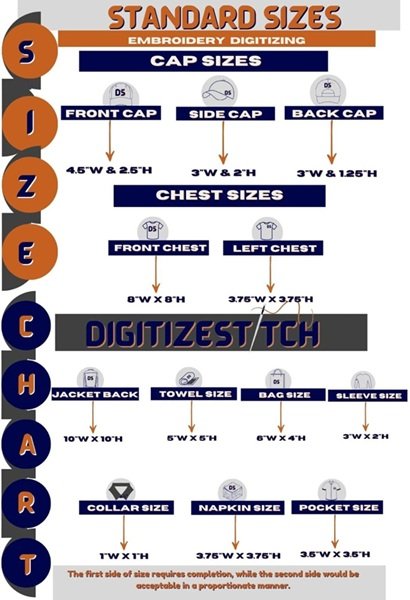Why Is An Embroidery Size Chart Important For Embroidery Digitizing?
Why Is An Embroidery Size Chart Important For Embroidery Digitizing? Embroidery digitizing is the process of converting designs, logos, or art into a format that an embroidery machine can read.

Embroidery digitizing is the process of converting designs, logos, or art into a format that an embroidery machine can read. One of the most important tools for successful digitizing is an embroidery size chart. It helps you determine the best size for your design, ensuring it looks great and works well on your chosen fabric or item. In this article, we will explore why an embroidery size chart is essential and how it supports the digitizing process.
Importance Of Embroidery Size Chart In Embroidery Digitizing
1. Ensures Accurate Design Sizing
An embroidery size chart provides standard measurements that guide you in selecting the right size for your design. Without accurate sizing, the embroidery might appear too large or too small for the item. For example, a design meant for a t-shirt pocket should be much smaller than a logo for the back of a jacket. By using a size chart, you can avoid mistakes and ensure your design fits perfectly.
2. Maintains Design Clarity
When creating embroidery designs, clarity is key. A design that is too small may lose details, making it look messy or unclear. On the other hand, a design that is too large might become distorted or overwhelm the item. The size chart helps you find the ideal balance, ensuring every detail is visible and the design looks professional.
3. Helps In Fabric Selection
Different fabrics work better with different embroidery sizes. A size chart helps you choose the right dimensions for your design based on the fabric type. For instance:
· Delicate fabrics like silk or chiffon need smaller designs to prevent damage.
· Sturdy fabrics like denim or canvas can handle larger and more intricate designs.
By consulting a size chart, you can avoid problems and achieve the best results for each fabric.
4. Simplifies Placement Decisions
Placement is a key part of embroidery. Whether you're working on a sleeve, collar, or the front of a cap, the placement of the design affects its size. An embroidery size chart gives guidelines for common placements. It helps choose the right dimensions. This ensures the embroidery looks balanced and professional.
5. Supports Machine Limitations
Embroidery machines have size limits. A design that is too large or small might not work well with your machine. A size chart helps you determine whether your design fits within the machine's capabilities. If you use custom embroidery digitizing services USA, pros can adjust your design size to meet your machine's requirements.
6. Saves Time And Effort
Planning embroidery sizes without a chart can involve a lot of guesswork, leading to trial and error. A size chart eliminates the need for many adjustments, saving you time and effort. It provides a clear starting point for creating or digitizing your design.
7. Improves Cost Efficiency
Larger designs need more thread and time to stitch, increasing production costs. By using a size chart, you can select the most cost-effective size without compromising quality. If you’re working on a budget, a size chart is an essential tool.
8. Guides Digitizing Settings
When learning how to digitize for embroidery, understanding size is crucial. The size of the design affects stitch type, density, and other settings. A size chart ensures your digitizing process matches the intended dimensions. This leads to better results.
9. Enhances Consistency For Multiple Items
If you are making embroidered items, like uniforms or promo goods, consistency is key. A size chart helps you maintain uniformity across all items, ensuring every piece looks the same.
10. Prevents Fabric Damage
Overly large designs can make fabrics stiff and heavy, while overly small designs may cause the fabric to bunch up. An embroidery size chart helps you select sizes that suit the fabric’s weight and texture, preventing damage and maintaining the item’s quality.
11. Adapts to Personal Preferences
While size charts provide guidelines, they also allow room for customization. You can use them to adapt designs to personal preferences or specific needs, ensuring the final result matches your vision.
12. Aligns With Industry Standards
For businesses, using a size chart ensures your designs meet industry standards. If you’re working with custom embroidery digitizing services USA. They will likely use size charts to ensure your designs are professional and high-quality. This alignment enhances your reputation and customer satisfaction.
What's Your Reaction?
















